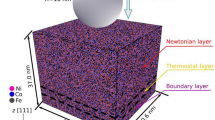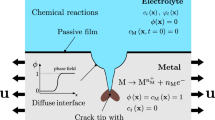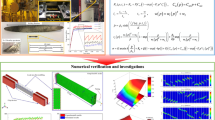Abstract
The paper deals with modelling of the plastic and creep deformation of metals coupled with current. The passage of DC manifests itself in the increase in creep deformation and leads to primary creep time shortening. With plastic deformation, a short electric impulse results in the step-wise decrease of stress (stress-drop) on the stress–strain diagram. To catch these phenomena, we utilize the synthetic theory of recoverable deformation. The constitutive equation of this theory is supplemented by a term taking into account the intensity of DC. Further, we introduce DC intensity into the function governing transient creep. As a result, we predict the parameters of transient creep and calculate the stress-drop as a function of current intensity. The model results show good agreement with experimental data.



Similar content being viewed by others
References
Andrawes, J., Kronenberger, T., Perkins, T., Warley, J.: Effects of DC current on the mechanical behavior of AlMg1SiCu. Mater. Manuf. Process. 22(1), 91–101 (2007)
Batdorf, S., Budiansky, B.: Mathematical theory of plasticity based on the concept of slip. NACA Technical Note, 871 (1949)
Callister, W.D., Rethwisch, D.G.: Materials Science and Engineering: An Introduction 7th edn. pp. 665–715. Wiley, New York (2007)
Chen, R., Yang, F.: Impression creep of a Sn60Pb40 alloy: the effect of electric current. J. Phys. D, Appl. Phys. 41(15), 155406 (2008)
Dudko, V., Belyakov, A., Kaibyshev, R.: Evolution of lath substructure and internal stresses in a 9% Cr steel during creep. ISIJ Int. 57(3), 540–549 (2017)
Hasija, V., Ghosh, S., Mills, M.J., Joseph, D.S.: Deformation and creep modeling in polycrystalline Ti–6Al alloys. Acta Mater. 51(15), 4533–4549 (2003)
Kinney, C., Morris, J.W., Lee, T.K., Liu, K.C., Xue, J., Towne, D.: The influence of an imposed current on the creep of Sn–Ag–Cu solder. J. Electron. Mater. 38(2), 221–226 (2009)
Kuksa, L.V., Lebedev, A.A., Koval’chuk, B.I.: Laws of distribution of microscopic strains in two-phase polycrystalline alloys under simple and complex loading. Strength Mater. 18(1), 1–5 (1986)
Li, W.Y., Zhou, M.B., Zhang, X.P.: Creep behavior of Cu/Sn-3.0 Ag-0.5 Cu/Cu solder joints under tensile stress coupled with DC current stressing. In: 2015 16th International Conference on Electronic Packaging Technology (ICEPT), pp. 187–192. IEEE Press, New York (2015)
Nguyen, T.T., Nguyen, T.V., Hong, S.-T., Kim, M.-J., Nam Han, H., Morestin, F.: The effect of short duration electric current on the quasi-static tensile behavior of magnesium AZ31 alloy. Adv. Mater. Sci. Eng. 2016, 9560413 (2016), 10 pages. https://doi.org/10.1155/2016/9560413
Perkins, T.A., Kronenberger, T.J., Roth, J.T.: Metallic forging using electrical flow as an alternative to warm/hot working. J. Manuf. Sci. Eng. 129(1), 84–94 (2007)
Piazolo, S., Montagnat, M., Grennerat, F., Moulinec, H., Wheeler, J.: Effect of local stress heterogeneities on dislocation fields: examples from transient creep in polycrystalline ice. Acta Mater. 90, 303–309 (2015)
Poirier, J.P.: Microscopic creep models and the interpretation of stress-drop tests during creep. Acta Metall. 25(8), 913–917 (1977)
Ross, C.D., Irvin, D.B., Roth, J.T.: Manufacturing aspects relating to the effects of direct current on the tensile properties of metals. J. Eng. Mater. Technol. 129(2), 342–347 (2007)
Rusinko, K.: Theory of Plasticity and Nonsteady Creep. Vyshcha Shkola, Lviv (1981) (in Russian)
Rusinko, A.: Modeling the effect of DC on the creep of metals in terms of the synthetic theory of irrecoverable deformation. Mech. Mater. 93, 163–167 (2016)
Rusinko, A., Rusinko, K.: Synthetic theory of irreversible deformation in the context of fundamental bases of plasticity. Mech. Mater. 41(2), 106–120 (2009)
Rusinko, A., Rusinko, K.: Plasticity and Creep of Metals. Springer, Berlin (2011)
Sanders, J.L. Jr.: Plastic stress–strain relations based on linear loading functions. In: Proceedings of the Second USA National Congress of Applied Mechanics, Ann Arbor, 14–18 June 1954, pp. 455–460 (1954)
Sanmartin, A., Kleinstück, K., Quyen, N.H., Paufler, P.: Influence of a direct current and a temperature gradient on the creep rate in \(\mathrm{V}_{3}\mathrm{Si}\). Phys. Status Solidi A 80(2), K171–K174 (1983)
Yang, F., Zhao, G.: Effect of electric current on nanoindentation of copper. Nanosci. Nanotechnol. Lett. 2(4), 322–326 (2010)
Zhao, G., Yang, F.: Effect of DC current on tensile creep of pure tin. Mater. Sci. Eng. A, Struct. Mater.: Prop. Microstruct. Process. 591, 97–104 (2014)
Zhao, G., Liu, M., Yang, F.: The effect of an electric current on the nanoindentation behavior of tin. Acta Mater. 60(9), 3773–3782 (2012)
Zhao, K., Fan, R., Wang, L.J.: The effect of electric current and strain rate on serrated flow of sheet aluminum alloy 5754. J. Mater. Eng. Perform. 25(3), 781–789 (2016)
Author information
Authors and Affiliations
Corresponding author
Rights and permissions
About this article
Cite this article
Rusinko, A., Varga, P. Modelling of the plastic deformation and primary creep of metals coupled with DC in terms of the synthetic theory of irrecoverable deformation. Mech Time-Depend Mater 23, 23–33 (2019). https://doi.org/10.1007/s11043-018-9379-y
Received:
Accepted:
Published:
Issue Date:
DOI: https://doi.org/10.1007/s11043-018-9379-y




